To Jomolhari base camp and back to yaks
There is a big difference...between Nepal and Bhutan.
Mostly because >80% of Bhutan is forested.
The day before we left for trekking, we had a short tour of the Dzong and Paro.
Massive beehives cling to the Dzong Monastery windows.
The inner courtyard is very quiet, and only a few monks and a few other tourists are visiting while we are there. Here are Thinley, Dave, Kinley, and Solveig.
The wall paintings in the Dzong are wonderful.
The view of Paro from the window of the Dzong shows what a small place it is and how agricultural the surroundings are.
Tourism is now a mainstay of the economy in Paro. The appearance of coffee cafes with yummy pastries and tourist shops filled with cheap trinkets, mostly from Nepal, is a new phenomenon.
Also present is a new fast-selling luxury item, Cordyceps, a performance-enhancing fungus that infects a moth living in the grassland at high elevations > 5000m. It earns good money for mountain people.
Early in the morning, we drive to the park entrance. The clouds are lingering on the peaks. We were hoping for better weather.Light blasts through the clouds, but unfortunately, it doesn't dispel them.
A lovely Bhutanese farmhouse close to the park.

Arriving at the Jigme Dorji Park entrance.
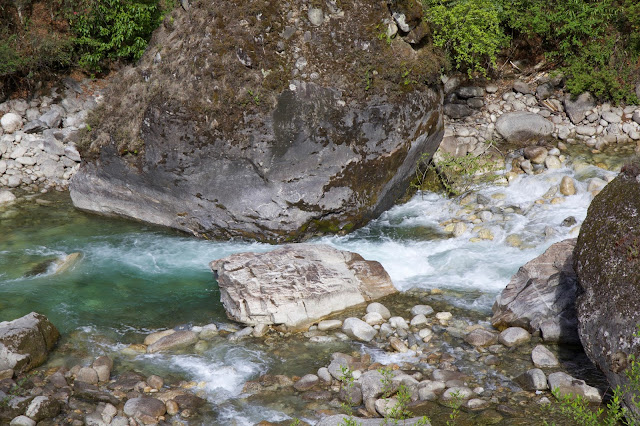

We start out next to a clear, bright blue stream. Clean water is a luxury that hardly exists in Nepal.
Birds are great in the forest above a Brown Bullfinch and below a Spotted Nutcracker, both new for me.
All the trees were draped with mosses. The forest looked so primitive,e and our path between the trees was fairly rocky and needed attention while walking.

Rhododendrons were blooming in pink and red, and some were orange and yellow.


The altitude just kept increasing. Our first day was overcast and threatening. It opened up fully when we arrived at our tents. We walked 14 km on the first day.

Power is reaching even the remote areas of Bhutan. We walked next to power lines from the entry of the park up all the way into the highest yak pastures. It was not always a welcome sight.

 Even at Jomolhari base camp or Jangothang, a wire connected the only two buildings there.
Even at Jomolhari base camp or Jangothang, a wire connected the only two buildings there.The problem with the power lines is that you have to try and avoid them in the photos - a metallic line across a lovely view is not pretty.
The remains of a Dzong, where the story was that a very cruel and unpopular ruler lived. He made his people work very hard, but when he asked them to remove the top of the mountain across the valley so that he could have more sun, they rebelled. The ruler escaped, and the people destroyed the Dzong.

Moving up the valley from the Dzong toward Jomolhari mountain, we heard that a snow leopard had tried to attack our houseman's mules the previous night. The fierce mastiff dogs at our camp heard the frightened mules, and their barking scared the leopard away. Their barking also kept us awake, but since it was for a good reason...

I found a yak skull with the horns cut off. Our friends told us that people cut them off and use them as tools. Maybe the yak was a victim of the local snow leopard.

Can you see it, the small brown fuzzy thing sticking out of the leaves? This is Cordyceps - gold for the mountain people. One fine piece of the fungus and the caterpillar that it is attached to provides a lot of money.


A Himalayan marmot was running for cover as we passed.
A small glacial lake had formed below Jomolhari peak as seen from the moraine.
 We noticed the weather was closing i, so we stopped looking for Cordyceps and followed the glacial runoff back down to the base camp.
We noticed the weather was closing i, so we stopped looking for Cordyceps and followed the glacial runoff back down to the base camp.


From left: Nidup, Horseman, Kinley, Thinley.
Snow pigeons We noticed the weather was closing i, so we stopped looking for Cordyceps and followed the glacial runoff back down to the base camp.
We noticed the weather was closing i, so we stopped looking for Cordyceps and followed the glacial runoff back down to the base camp.
Our friends and experts from the Bhutan Government graciously helped us every step of the way and introduced us to their areas of expertise - yaks, pastures, and mountains!

From left: Nidup, Horseman, Kinley, Thinley.
Our morning was clear for a change. We hoped the day would stay bright as we had to walk over a 4910m pass to Soi Yaktsa.
Crow-like - Alpine Choughs were waiting for us to finish breakfast.
So long to the fort and view of mountains, we were going higher, and views would not happen again.
The newly installed electric wires were soon behind us as we walked up the ridge just behind the wires.
We quickly got ready to go while the weather was good, and we made our way to the steep slope to reach a yak pasture and lake on top.

The water was so blue. Our weather was still ok, so we stopped to pose next to the sign.
From higher up, we could see more of the lake - hard to say how deep it wa, but the color was amazing even with cloud cover.
The edge of the lake was fed from a large mass of snow higher up.
Yaks were there to graze on the new grasses that were just emerging, but it wasn't springtime yet, and it didn't look like there was much grass for them.
A tiny red velvet mite was in the moss on the rocks - hard to see at first, but the contrast between it and the surroundings was significant.
Helle, arriving from sea level in Norway, thought that a horse was the best option for climbing at high altitudes, but she found it was not what she thought.
As we passed the lakes and up a pass, the weather quickly started to change, and soon snow flurries were racing past us on a strong wind.
It was not so cold, but getting wet was not a good idea, so we put on our ponchos and walked on toward a 4910m pass.


The trail is in the foreground above - winding down down down...to

Soy Yaktsa and the house below, where our horseman lives, and his niece in the small house on the left. Again, in this valley, what did we find - power lines! Even in the most remote areas.
The niece's house was a small, one-story, solid-built home that she shared with her brother, who was unable to speak but was a good carpenter.
She divorced her husband and managed everything on her own - she looks very capable.

Our cook arrived long after we did every day, exhausted and complaining of sore feet and legs - he did have a lot of weight to carry. He was a good cook and even made us a wonderful cake for Norway Day and our wedding anniversary.
The whole group assembled for cake. Solveig sang the Norwegian anthem.

A bit of a grizzly entrance - we slept upstairs in this building in the prayer or puja room. The room is on the top floor of the photo below.
The next morning, we were off again with uncertain weather, so best to leave early. We passed a large hole to the stream below - it was quite a drop.
A lovely Buff-barred Warbler in a Rhododendron.

A group photo before heading off to the yak pastures. There were Helle, Solveig, Karen, Nidup, Kinley, and Thinle, with Dave taking the photo.

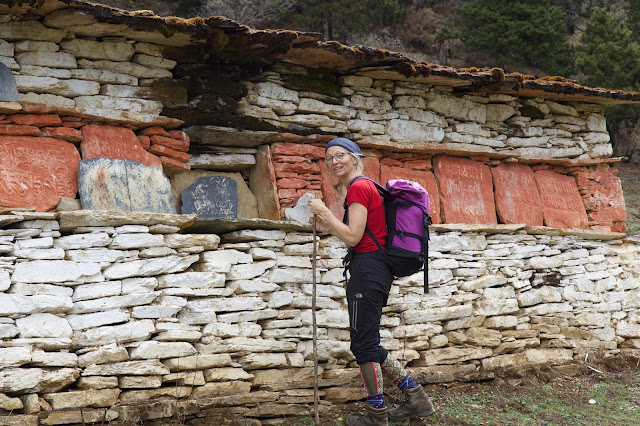
Solveig with her special stone at the mani wall.

Dave and I added to the marker at the top of the pass and below two young yak herders that we met on top.
Around the corner in the distance was a small yak herder lodge where we stopped for lunch. In the distance to the right, under the cloud,s is the pass we were heading for.
Lunch break before the clouds came to get us on the path again.
There were so many primulas in bloom - small violet heads of them peeking out from bunches of grasses that would soon be grazed on.
Dave is with Nidup, having a bit of a lunchtime siesta.
Our horseman passed by with our tents and bags.
Yaks also passed by as we looked down on another yak herder's house.

A very nicely decorated yak with dyed yak hair earrings.
 Heading toward the pass, a blue sheep peers down on us.
Heading toward the pass, a blue sheep peers down on us.
Two male blue sheep have a tussle on the steep rocky slope.
At the pass, we can see the Thombu Shong valley ahead, where we will camp. Clouds block the snowy mountain peaks that should be above the valley.



The family's summer home (below) doesn't look like much, but they seem quite happy there with their yak milk and cheese.
A few birds were there, like the Plain-backed Thrush.
A Pink-browed Rose Finch
Our team, who cooked and served food for us with a smile, were wonderful people.
The last part of the trek was 4 hours of steep downhill walking. Ouch, my poor toes. I took a few parting photos of flowers, like this red spurge, or Euphorbiaceae.
Back to the cars and our meeting with friends. We shared momos and tea before heading off in different directions.
They look happy to go home. It was a fantastic trip.
 Heading toward the pass, a blue sheep peers down on us.
Heading toward the pass, a blue sheep peers down on us.Two male blue sheep have a tussle on the steep rocky slope.
At the pass, we can see the Thombu Shong valley ahead, where we will camp. Clouds block the snowy mountain peaks that should be above the valley.

Our tents show up in the distance behind Solveig. The photo below shows the wide pasture lands of Thombu Shong that were quickly filling up with yaks.

Dave and Thinley walk down toward the camp.
Hundreds of grazing yaks/naks, some with newborn calves.
The heavy clouds were still with u, but with a yak, in the foreground on the ridge, they were quite pretty.

Yak herders are tough people; they have to be in such a remote place. One woman was very proud of her harvest of Cordyceps. She was hunting for them while her animals were grazing.
True mountain women. They live a healthy lifestyle outside, but inside their home, smoking is a health problem.The family's summer home (below) doesn't look like much, but they seem quite happy there with their yak milk and cheese.
The next morning, after leaving the yak pasture, we walked up a small slope and then along a ridge for three hours. One side was solid rhododendrons, and the other a steep rocky slope.
A Pink-browed Rose Finch
Hill-topping butterflies like the Yellow Swallowtail (Rimpoche)
The ridgeline rhododendrons were again different from the previous days; they were more like small shrubs with white or yellow flowers mixed with some larger bright pink types that were just opening.The last part of the trek was 4 hours of steep downhill walking. Ouch, my poor toes. I took a few parting photos of flowers, like this red spurge, or Euphorbiaceae.
Back to the cars and our meeting with friends. We shared momos and tea before heading off in different directions.
They look happy to go home. It was a fantastic trip.







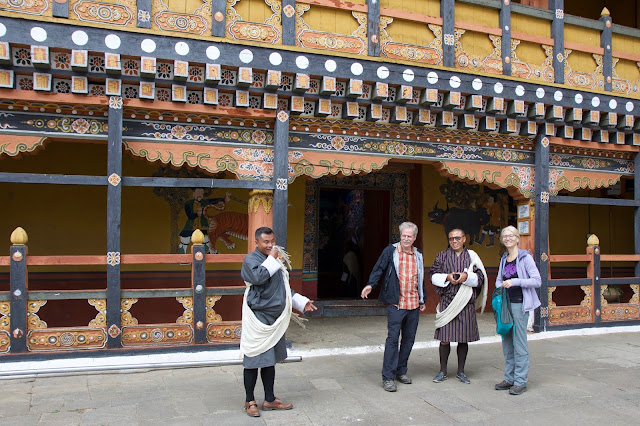





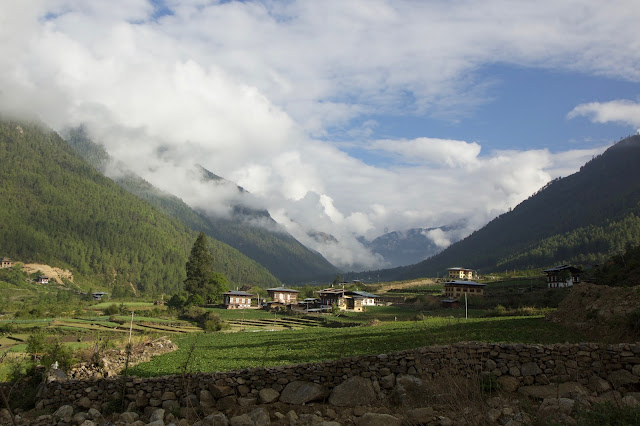

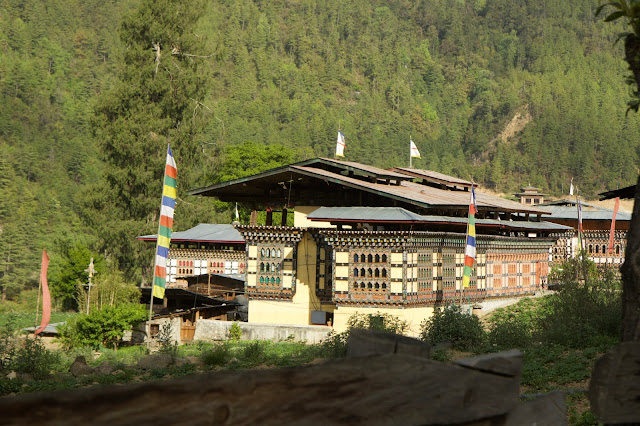

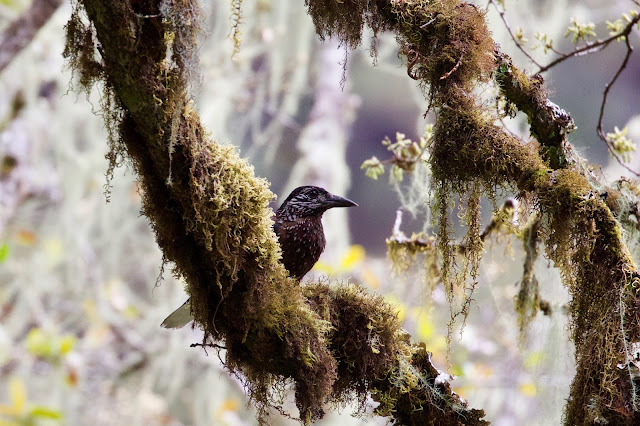




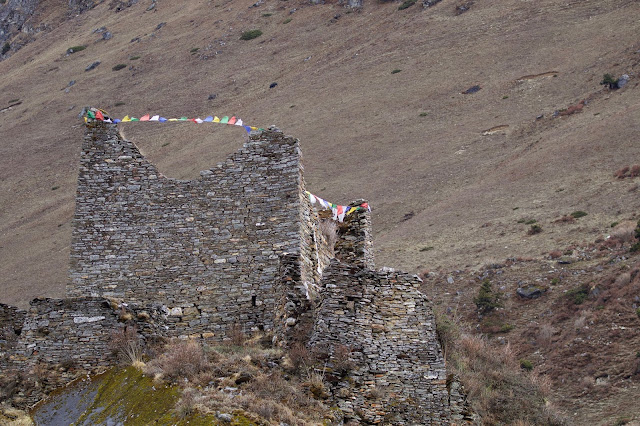







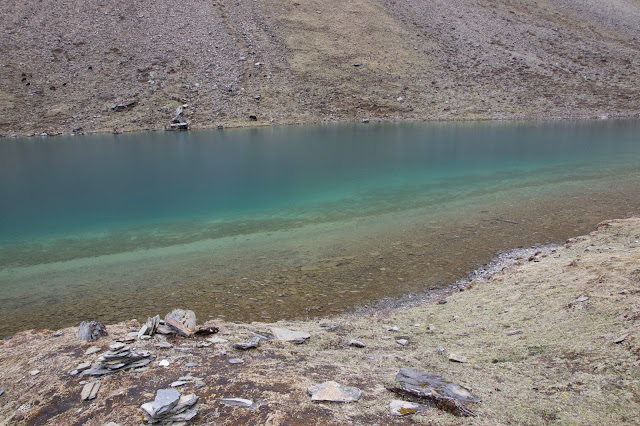


























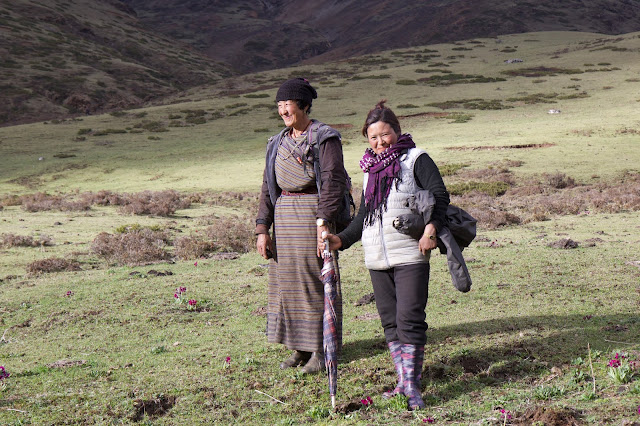




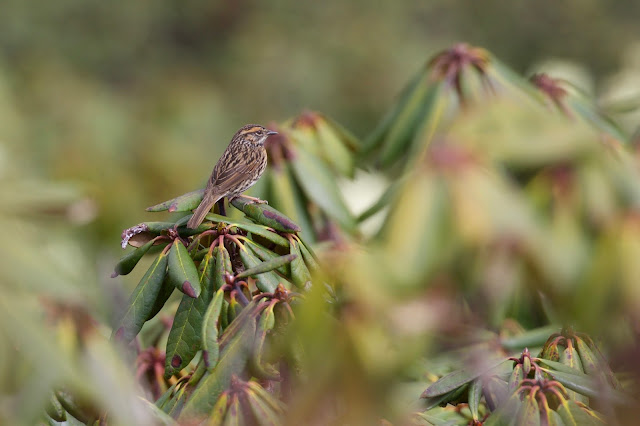











Comments
Post a Comment